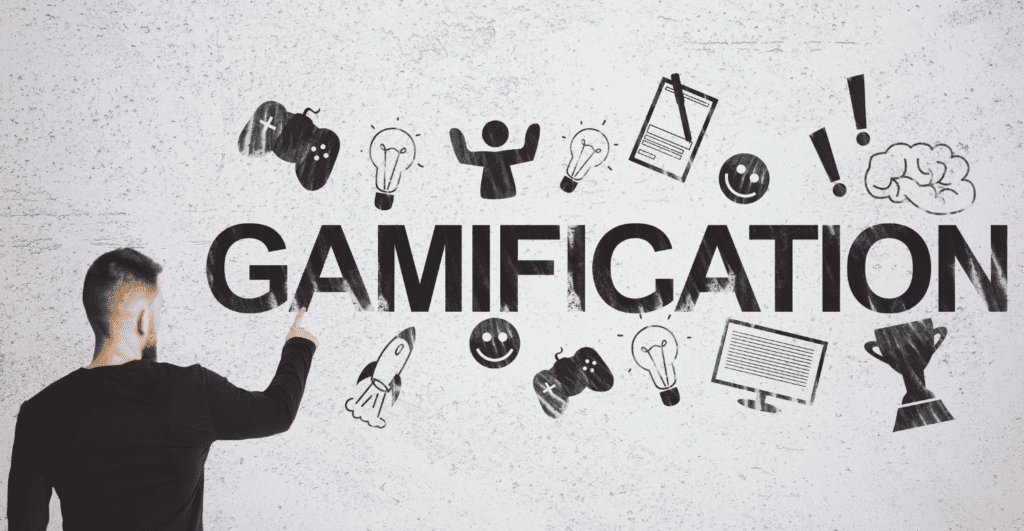Customer retention is crucial for sustainable growth and profitability in the fast-paced business world. However, keeping customers loyal can be challenging when so many options are available. That's where gamification elements come in.
Table of Contents
Gamification involves incorporating game mechanics and elements into non-game situations, and it has become a powerful strategy for captivating audiences and reducing customer retention costs.
By adding gamification elements like points, levels, challenges, and rewards to customer interactions, businesses are finding a new way to engage customers, build lasting relationships, and save money on acquiring new customers.

For example, integrating gamified reward programs into email marketing campaigns can boost customer lifetime value by 48% and increase the conversion rate by 15%. This ultimately lowers the amount you need to spend on retaining your customers.

However, if you are still unsure whether to use gamification elements in your marketing strategy, this blog post is for you. Today, we will explain how including gamification elements can lower customer retention costs. Read on!
Understanding the Gamification Revolution
Gamification taps into basic human tendencies like our desire for achievement, progress, and recognition. By incorporating elements like points, levels, challenges, rewards, and competitions into non-game situations, businesses create immersive experiences that deeply connect with their customers.
It's not just about making tasks into games; it's about using play to foster engagement and commitment. These gamification elements activate psychological triggers, resulting in a sense of accomplishment and satisfaction as customers advance through levels or earn rewards.
Additionally, they make the experience more interactive and enjoyable.
How Does Gamification Boost Customer Retention and Reduce Retention Cost?
Now, let's explore how gamification can be a cost-effective key factor in customer retention.
1. It Boosts Engagement
The appeal of gamification is its power to turn passive consumers into active participants. Loyalty programs are a prime example. Instead of just offering discounts or rewards, gamified loyalty programs go a step further.
They use tiers, badges, and personalized challenges to increase engagement. This encourages customers to regularly interact with the brand, not just as buyers but as active participants in an exciting journey.
For example, the Canva Design Challenge encourages users to create a design such as a poster, custom sticker, or social media graphic based around a theme. Then, users share their design on social media while tagging Canva and using the hashtag #CanvaDesignChallenge.
2. Reduction in Acquisition Cost
Acquiring new customers can be expensive, requiring investments in advertising, marketing campaigns, and discounts. However, gamification offers a different approach by fostering loyalty among existing customers, who then become brand advocates.
Through engaging experiences and rewards, these loyal customers are more likely to refer their friends and family, serving as ambassadors at a lower cost compared to acquiring new clientele.
3. Increased Customer Lifetime Value (CLV)
By implementing gamification, businesses can increase customer retention and lifetime value. Engaging customers through gamified interactions builds a sense of community and fosters ongoing participation, reducing churn rates.
Consequently, these engaged customers generate higher revenue over time, surpassing the value created by one-time transaction customers.
4. Optimized Marketing Spend
Traditional marketing aims to reach a broad audience, including current and potential customers. In contrast, gamification allows businesses to deliver customized experiences by analyzing customer behavior. This data-driven strategy offers valuable insights and enables smarter marketing efforts that optimize resources for maximum impact.
5. Understanding Customer Psychology
A key factor in the success of gamification is its alignment with basic psychological principles. Humans naturally desire challenges, strive for goals, and take joy in their achievements. Gamification taps into this inherent motivation by providing an environment that gives customers a sense of growth, accomplishment, and community.
Best Tips for Using Gamification Elements to Reduce Customer Retention Costs
Here are five tips on how to effectively use gamification elements to lower customer retention costs:
1. Data-Driven Personalization
- Analyze user behavior, preferences, and past interactions to customize challenges, rewards, and levels.
- By comprehending individual customer journeys, businesses can create unique experiences connecting with each user, increasing engagement and loyalty.
- You can categorize customers based on preferences and design tailored challenges or rewards for each segment, ensuring a focused and efficient retention strategy.
For example, the fitness app Strava provides personalized challenges tailored to a user's running or cycling routines. For example, if a user consistently runs 5 kilometers daily, Strava could propose a challenge to enhance that distance by 10% in just one week.
This individualized goal-setting keeps users engaged and motivates them to stick to their fitness regimen, promoting lasting loyalty without the need for costly marketing efforts.
2. Social and Community Engagement
- Promote a strong sense of belonging and community on the gamified platform by incorporating social features such as leaderboards, forums, and collaborative challenges.
- Facilitating connections, competitions, and collaborations among users not only enhances their engagement with the brand but also cultivates a loyal community.
- By encouraging interactions and shared experiences, businesses can minimize customer churn as users develop a strong emotional attachment to their community.
Duolingo, a popular language learning app, is the best example of it. It adds a social touch by letting users compete with friends, send hearts for extra lessons, and share achievements. This gamification and integration of social features create a lively community where users are driven by personal growth, friendly competition, and support. Thus, constant advertising to retain users is minimized.
3. Tiered Loyalty Programs with Meaningful Rewards
- Consider implementing a tiered loyalty system with attainable milestones and valuable rewards. It can encourage ongoing customer engagement.
- Remember, it is important to maintain a balance between making rewards achievable and desirable. Providing rewards that customers genuinely aspire to earn will help maintain motivation and boost customer retention.
- Furthermore, periodically introducing new rewards and exclusive benefits will help sustain interest and participation in the gamified program.
Consider the example of Sephora's Beauty Insider program. It has different tiers (Insider, VIB, Rouge), allowing customers to unlock rewards as they level up. These rewards include exclusive products, birthday gifts, and access to special events.
By providing attractive rewards tied to reachable spending goals, Sephora encourages customers to spend more to reach the next tier.

4. Interactive and Gamified Quizzes
- Gamification elements can serve as more than just entertainment; it can also be educational.
- By incorporating interactive features like quizzes, challenges, or tutorials, you can provide knowledge and skills pertaining to your product or service.
For instance, the “Weekly News Quiz” by The New York Times invites readers to test their knowledge of current events, blending news consumption with a fun and interactive experience.
By gamifying the news, the Times boosts reader engagement and potentially boosts subscriptions while reducing churn rates. This approach keeps readers informed, interested, and more likely to remember what they've learned.
5. Progress Tracking and Goal Setting
- You can empower customers by giving them tools to track their progress and set personal goals in the gamified system.
- Using visual indicators for progress, goal-setting features, and achievement trackers can help create a sense of accomplishment and direction.
- When users are able to see how far they've come and set their own objectives, they feel more involved in their journey with the brand. This fosters a sense of ownership and motivation, encouraging them to stay engaged and achieve their goals.
For example, Fitbit, a prominent fitness tracker company, uses gamification to motivate physical activity. Users establish fitness goals, monitor their progress, and engage in friendly competition or participate in challenges through the Fitbit app. The app grants badges and achievements as rewards for meeting milestones or finishing challenges.
Final Words on Gamification Elements
As the business world evolves, gamification becomes increasingly vital for customer retention. Its power to create emotional connections, boost engagement, and lower retention costs positions gamification as an essential tool for competitive businesses.
By tapping into the human desire for engagement and achievement, businesses can establish lasting connections with customers while reducing the costs of acquiring new ones. As industries embrace gamification, the blending of engagement, loyalty, and cost-effectiveness will drive businesses toward long-term success and growth.


